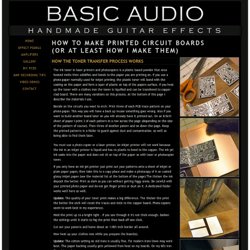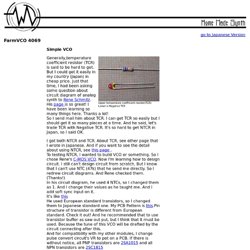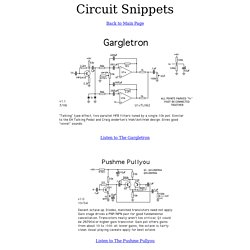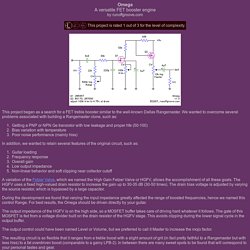

Fx. How to make printed circuit boards, diy pcb, Basic Audio. How the toner transfer process works The ink toner in laser printers and photocopiers is a plastic based powder that once heated melts then solidifies and bonds to the paper you are printing on.

If you use a photo paper normally used for inkjet printing, the plastic toner will bond with the coating on the paper and form a layer of plastic on top of the papers surface. If you heat up the toner with a clothes iron the toner is liquified and can be transfered to copper clad board. There are many variations on this process. At the bottom of this page I describe the materials I use. Decide on the circuits you want to etch. Synth Schematics. Wie andere Bereiche der Universität auch ist das HRZ durch ständig verknappende Ressourcen bei drastisch steigenden Anforderungen gezwungen, sich noch weiter auf die Erbringung von Kerndiensten zu konzentrieren und inhaltlich ähnliche Dienste nicht mehrfach vorzuhalten.

In der jetzt anstehenden Konsolidierungsphase werden wir die Bereiche File- und Webservice umstrukturieren. VCO 4069. Simple VCO.

702A to 5998A. Which diy bass preamp?.. Circuit Snippets. Circuit Snippets Back to Main Page Listen to The Gargletron Listen to The Pushme Pullyou Listen to The Tripple Fuzz Listen to the Cinnabar.

"Little Angel" - Super Simple PT2399 Mini Chorus. CJ, I'm curious as to how useful you are finding the more 'miniumum' settings. Strictly from a bench testing standpoint, I keep the depth all the way up. I haven't really tried it out in the context of what the minimum settings sound like, but I can tell you that with speed at minimum and depth maybe half way, it does a nice fattening thing to the signal. I also added a switch to mine that toggles R18 between 10K and 680R. There's a big difference, as you might imagine, between the two in terms of how intense the pitch shifting is. Omega. This project began as a search for a FET treble booster similar to the well-known Dallas Rangemaster.

We wanted to overcome several problems associated with building a Rangemaster clone, such as: Getting a PNP or NPN Ge transistor with low leakage and proper hfe (50-100)Bias variation with temperaturePoor noise performance (mainly hiss) In addition, we wanted to retain several features of the original circuit, such as: Guitar loadingFrequency responseOverall gainLow output impedanceNon-linear behavior and soft clipping near collector cutoff A variation of the Fetzer Valve, which we named the High Gain Fetzer Valve or HGFV, allows the accomplishment of all these goals. During the development we found that varying the input impedance greatly affected the range of boosted frequencies, hence we named this control Range. The output impedance of the HGFV is on the high side, so a MOSFET buffer takes care of driving hard whatever it follows. Analog Alchemy. "Little Angel" - Super Simple PT2399 Mini Chorus. Another absurd thing you could do is use the PT's clock as the input to something like this , with just a smallish smoothing cap, and feed the LFO output back into pin 2, which would give you a relatively painless and easy hypertriangular LFO.
Circuit Salad. Lots of great PT2399 designs out there…..

I have tried a number different variations and have built what I consider a best performance design, using a compander, elaborate filters, etc. I have been frustrated as many builders out there are – that the PT2399 is so easy to use but that it just goes to crap with longer delay times! So I decided to work and experiment with different approaches to converge on a simple, yet well performing design. I am really happy with what I have come up with. The design uses a discrete FET input buffer and uses one of the on board op amps as the wet/dry mixer.
Below are the schematic, a picture of a breadboarded prototype and some example audio of the prototype below, in use. Octobooster.jpg (JPEG-Grafik, 925 × 500 Pixel) Analog Alchemy. YATS with Baxandall tone stack. Ver Tema - Pedal DIY: 142 Magic Fuzz. [Traigo este topic de zonadiyer, que originalmente lo hice allá, y los chicos me ayudaron con mis problemas newbies... ; gracias chicos] He aquí el Catalibread SFT (Stand for This) Básicamente, es un pedal pensado para bajo (se lo vende como "bass overdrive"), pero yo lo uso con viola, para tener un pedal de rangos de sonido graves (stoners feels happy)... algunos dirán que es una disto, otros que es un fuzz (yo). Fuente: ... &start=140 Bueno amigos, después de que no pude hacerlo funcionar con una de las versiones de layout & pcb, y puesto que ESTA VEZ no me había mandado ninguna cagada (al menos nunca di con ella)... me harté, y mandé todo al carajo.. hice otra placa de otro proyecto del mismo pedal (posteado en el mismo thread de freestompb), ya que había varios users a los que con ESE les había andado... y utilizando todos los componentes del primer intento fallido, armé la otra versión.
Les dejo las dos versiones, por si alguien quiere intentar: #1 - Versión que no me funcionó: 2N Series - ( T ) Transistors. Untitled. Copyright R.G.

Keen 2001. All rights reserved. No permission for local copies or redisplay from web sites other than.